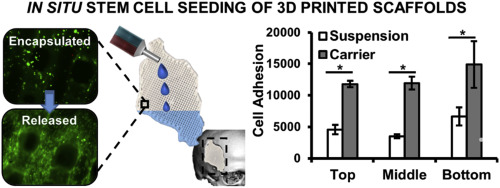Biomaterials ( IF 14.0 ) Pub Date : 2018-09-18 , DOI: 10.1016/j.biomaterials.2018.09.027 Michael Whitely , Stacy Cereceres , Prachi Dhavalikar , Karim Salhadar , Thomas Wilems , Brandon Smith , Antonios Mikos , Elizabeth Cosgriff-Hernandez

|
The design of tissue engineered scaffolds based on polymerized high internal phase emulsions (polyHIPEs) has emerged as a promising bone grafting strategy. We previously reported the ability to 3D print emulsion inks to better mimic the structure and mechanical properties of native bone while precisely matching defect geometry. In the current study, redox-initiated hydrogel carriers were investigated for in situ delivery of human mesenchymal stem cells (hMSCs) utilizing the biodegradable macromer, poly(ethylene glycol)-dithiothreitol. Hydrogel carrier properties including network formation time, sol-gel fraction, and swelling ratio were modulated to achieve rapid cure without external stimuli and a target cell-release period of 5–7 days. These in situ carriers enabled improved distribution of hMSCs in 3D printed polyHIPE grafts over standard suspension seeding. Additionally, carrier-loaded polyHIPEs supported sustained cell viability and osteogenic differentiation of hMSCs post-release. In summary, these findings demonstrate the potential of this in situ curing hydrogel carrier to enhance the cell distribution and retention of hMSCs in bone grafts. Although initially focused on improving bone regeneration, the ability to encapsulate cells in a hydrogel carrier without relying on external stimuli that can be attenuated in large grafts or tissues is expected to have a wide range of applications in tissue engineering.
中文翻译:

使用释放细胞的水凝胶改善3D打印支架的原位播种
基于聚合的高内相乳液(polyHIPEs)的组织工程支架的设计已成为一种有前途的骨移植策略。我们先前曾报道过3D打印乳液油墨能够更好地模仿天然骨骼的结构和机械性能,同时精确匹配缺陷几何形状的能力。在当前的研究中,研究了氧化还原引发的水凝胶载体用于利用可生物降解的大分子单体聚(乙二醇)-二硫苏糖醇原位递送人间充质干细胞(hMSC)。调节水凝胶载体的特性,包括网络形成时间,溶胶-凝胶分数和溶胀率,以实现快速固化而无外部刺激,目标细胞释放期为5-7天。这些就地载体可以改善3D打印的polyHIPE移植物中hMSC的分布,优于标准悬浮接种。此外,载有载体的polyHIPEs支持释放后hMSC的持续细胞活力和成骨分化。总之,这些发现证明了这种原位固化的水凝胶载体在增强骨移植物中hMSCs的细胞分布和保留能力方面的潜力。尽管起初专注于改善骨再生,但是在不依赖外部刺激的情况下将细胞封装在水凝胶载体中的能力有望在大型移植物或组织中减弱,这有望在组织工程中得到广泛的应用。



























 京公网安备 11010802027423号
京公网安备 11010802027423号